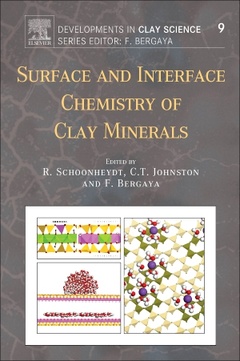Description
Surface and Interface Chemistry of Clay Minerals
Developments in Clay Science Series
Coordinators: Schoonheydt Robert, Johnston Cliff T., Bergaya Faïza
Language: English
Subject for Surface and Interface Chemistry of Clay Minerals:
Keywords
Absorption; Acid–base equilibria; Adsorption; Adsorption isotherms; Adsorption kinetic; Adsorption mechanisms; Aggregation; Asymmetric synthesis; Binding sites; Biopolymers of the first life; Casting; Cation exchange; Chiral recognition; Chiral sensing; Chirality; Clay; Clay mineral film; Clay mineral layer; Clay mineral surface; Clay minerals; Complexation; Controlled delivery; Degradation; Density functional theory; Dye; Electronic property; Emission; Enantiomer; Enantioselective sensing; Energy transfer; Halloysite; Heavy metals; Hybrid; Hysteresis; Illite; Intercalation; Interlayer cation; IR; Iridium; Iron; Kaolinite; Langmuir–Blodgett; Layer by layer; LB; LbL; LDH; Metal nanoparticles; Molecular dynamics simulations; Molecular modelling; Montmorillonite; Nanoporous clay minerals; NMR; Nonlinear optics; Optical resolution; Organic synthesis; Orientation; pH; Photosensitiser; Pigment; Pillared clays; Pollutants; Protection; Racemic; Radionuclides; Ruthenium; Smectite; Soft and hard proteins; Spectroscopy; Spin coating; Supported clay mineral catalysts; Surface complexation; Swelling; Synthetic hectorite; Synthetic saponite; Time-resolved fluorescence; Tris(chelated) metal complex; Vibrational circular dichroism; Water; Water adsorption; XRD
426 p. · 15x22.8 cm · Paperback
Description
/li>Contents
/li>Biography
/li>Comment
/li>
Surface and Interface Chemistry of Clay Minerals, Volume 9, delivers a fundamental understanding of the surface and interface chemistry of clay minerals, thus serving as a valuable resource for researchers active in the fields of materials chemistry and sustainable chemistry. Clay minerals, with surfaces ranging from hydrophilic, to hydrophobic, are widely studied and used as adsorbents. Adsorption can occur at the edges and surfaces of clay mineral layers and particles, and in the interlayer region. This diversity in properties and the possibility to tune the surface properties of clay minerals to match the properties of adsorbed molecules is the basis for study. This book requires a fundamental understanding of the surface and interface chemistry of clay minerals, and of the interaction between adsorbate and adsorbent. It is an essential resource for clay scientists, geologists, chemists, physicists, material scientists, researchers, and students.
Robert A. Schoonheydt, Faiza Bergaya and Cliff T. Johnston
2. Determination of Surface Areas
Laurent Michot
3. Quantum-chemical modeling of surfaces and of surface-adsorbate interactions
Sergey V. Churakov and Xiandong Liu
4. Adsorbed water
Cliff T. Johnston
5. Heavy metal adsorption, including radionuclides
Bart Baeyens and Maria Marques Fernandes
6. From transition metal ion complexes to chiral clay minerals
Sato Hisako
7. Organic pollutants adsorption on clay minerals
Jean François Lambert
8. Proteins adsorption on clay minerals
Maguy Jaber, Jean François Lambert and Sébastien Balme
9. Clay mineral catalysts
Dipak Kumar Dutta
10. From polymers to clay mineral-polymer nanocomposites
Faiza Bergaya, Robert A. Schoonheydt and Fernando WYPYCH
11. From adsorbed dyes to optical materials
Jun Kawamata
12. Clay mineral films
Yasushi Umemura
Cliff Johnston is a Professor of Earth, Atmospheric and Planetary Sciences and Agronomy at Purdue University, West Lafayette, Indiana USA. He serves as a Deliberate Innovation for Faculty Director at Purdue University. His research program focuses on the surface chemistry of clay minerals and related environmental particles. Most of his research of focused at the ‘molecular scale’ where he examines the molecular mechanisms of processes occurring at the mineral-water interface. He has published over 144 journal articles, book chapters and edited books. He has served as President of The CMS (Clay Minerals Societies) and has received numerous awards. He has been invited to give keynote lectures at several conferences and collaborates with researchers throughout the world.
Dr Faiza Annabi-Bergaya obtained a Licence-ès-Science in Physical-Chemistry from the University of Tunis in 1966, a first PhD in Inorganic Chemistry in 1971 from University La Sorbonne-Paris VI and a second PhD in Physics in 1978 from the University of Orleans (France). She started her career in 1971 at the CNRS from which she is presently Emeritus Research Director. Her research interest is focused on the Physics and Chemistry of clays and clay minerals. She is member of the AIPEA Nomenclature Co
- Presents scientists and engineers with a resource they can rely on for their own research and work involving clay minerals
- Includes an in-depth look at ion exchange, adsorption of inorganic and organic molecules, including polymers and proteins, and catalysis occurring at the surfaces of clay minerals
- Includes materials chemistry of clay minerals with chiral clay minerals, optical materials and functional films
These books may interest you

Clays in the Critical Zone 71.34 €



